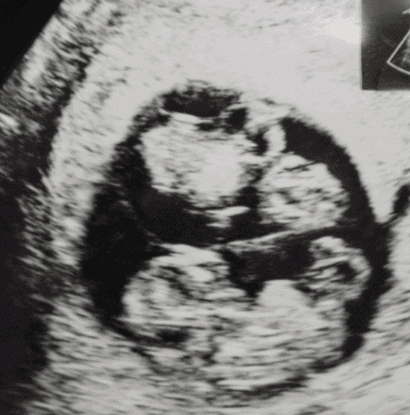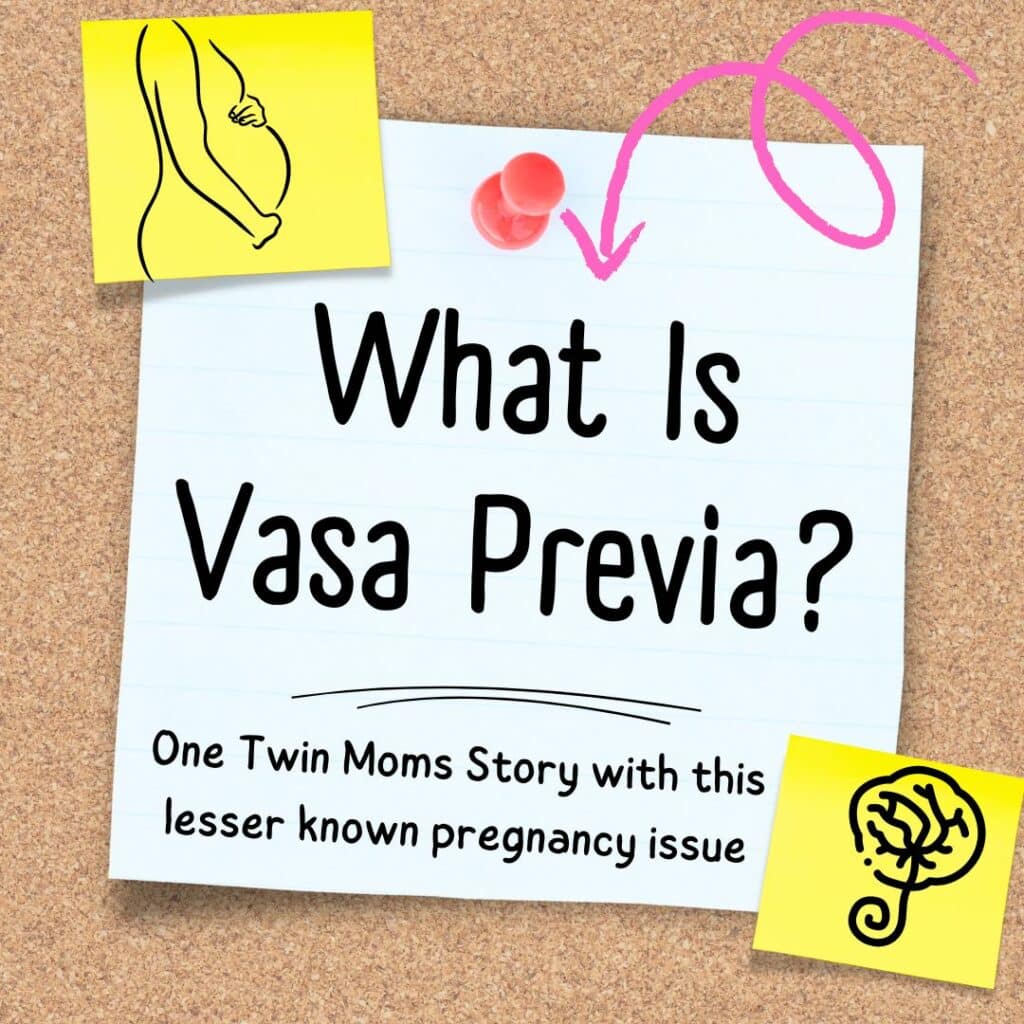Last updated on April 11th, 2024 at 03:20 pm



Have you been diagnosed with vasa previa? Check out this twin mom’s story to gain some hope and perspective.
The placenta is a magical organ that takes lots of energy (and morning sickness) for a mom’s body to create from scratch! But what happens when it’s not functioning as intended or in the wrong place? Most people have probably heard the terms “low-lying placenta” or “placenta previa” as they learn more about pregnancy but what about Vasa Previa? It’s not as commonly discussed or even known about. Here is one mom’s journey, or shall we say “adventure” which led to her discovering that she had vasa previa.
“There were no issues with my first two pregnancies, so I was caught by surprise when one ultrasound changed the course of the pregnancy. I would require a C-section and an early one at that. We went from discussing a 38 week vaginal delivery for our Di-Di twins to debating whether 34 or 35 weeks would be safer and how much NICU time would be necessary.
So, how did this happen?

One More Time
Let’s try for one more…famous last words my husband always reminds me of regularly. Our four-year-old son told us there were two babies the day before my 9.5-week appointment so we were relatively calm when the ultrasound technician broke the news that there was a second heartbeat. Besides a chuckle at my four-year-old’s premonition, all I was able to say was we needed a bigger car.
The pregnancy was going well, even with the pretty intense morning (all day) sickness. We had our anatomy scan at 20 weeks with everything looking good, except for that little summary note that said Baby A’s placenta was very close to the opening of my cervix. My OB contacted me reassuring me that it is common, and would likely move away as the pregnancy progressed.
Diagnosis Day
At my 29 week ultrasound, we were told the low-lying placenta has resolved! Great news! But the ultrasound technician wanted to take another look at my cervix area using a transvaginal ultrasound. I was initially confused as to why it would be necessary at this point in my pregnancy. She said they wanted to take a look to make sure the vessels that attach the placenta to the uterus had also moved. In my case, they had not. A doctor came into the room to conduct his own exam. There was still hope that the vessels could be maternal vessels (mom’s blood) and not fetal vessels. Using a Doppler they determined that the vessels were in fact my Baby A’s vessels, and just like that everything changed.
I was diagnosed with Vasa Previa. Vasa previa is defined by the International Vasa Previa Foundation as “a rarely reported condition in which exposed fetal vessels traverse the amniotic membranes between the baby’s presenting part and the internal cervical os, unprotected by placental tissue or umbilical cord.” In non-medical jargon, my Baby A’s vessels were not protected and an attempted vaginal delivery could have resulted in tremendous blood loss if they were to rupture.

Now What?
I was on pelvic rest. In fact, they emphasized that even a pelvic exam should not be performed as there is a risk of affecting the cervix and vessels. At that point, we began seeing a Maternal-Fetal Medicine doctor (MFM). As recommended by the MFM, I was admitted to the hospital at 32 weeks. And that is where I stayed until the girls were safely delivered via a scheduled C-section at 34.5 weeks.
The day-to-day in the hospital was pretty quiet with a daily non-stress test and flushing of my IVs. The hospital’s policy was to keep two working IVs ready to go in case of an emergency that would result in an emergency C-section. I was given two doses of steroids at 33 weeks to help get the twin’s lungs ready for the outside world.
The C-section was relatively calm and the girls (we didn’t know the sexes ahead of time) came out crying and the prettiest rose color I’d ever seen. Because of the Vasa Previa, I was able to see my Baby A for a few minutes, but she was moved pretty quickly to the NICU for evaluation. My Baby B was able to hang out in the OR with us for a little while longer until she was taken to the NICU as well. Both girls spent about two weeks in the NICU learning to remember to breathe while eating. Now they are 20 months old and into everything!

Want to get weekly emails about your twin pregnancy? Sign up for the Twiniversity email list! Subscribe today to get emails about giveaways, events, weekly article roundups, and more! We’ll be sending you a weekly twin pregnancy email to keep you on track with your pregnancy to-do list! Click here to learn more… and while you’re at it, check out our expecting twins classes and personal twin parent coaching services.
Knowledge is Power!
This isn’t intended to scare anyone. It is important to know what vasa previa is and how to manage it. When diagnosed and monitored, an early delivery almost always results in a healthy baby. Check out this list of risk factors from the International Vasa Previa Foundation’s website:
- velamentous cord insertion
- bilobed placenta
- succenturiate-lobed placenta
- low-lying placenta or placenta previa (even if it corrects itself!)
- pregnancies resulting from in-vitro fertilization
- multiple pregnancies
- maternal history of D&C or uterine surgery

What causes vasa previa?
Vasa Previa is caused by one of two things. The first is called velamentous insertions. That is when the cord is inserted directly into the membrane which leaves the vessels unprotected. The second cause is called a bilobed placenta, which means that the placenta is two pieces instead of one.
How serious is vasa previa?
Vasa previa is very serious. When it goes undiagnosed and a mom goes into labor, it can lead to hemorrhage and fetal death. The good news is that in developed countries like the U.S. vasa previa is most often diagnosed during pregnancy. When diagnosed prenatally, it almost always results in a healthy c-section delivery. A c-section before mom goes into labor is the safest way to deliver a baby when you have a vasa previa diagnosis.

Can vasa previa correct itself?
A 2019 study states that about 39% of the time, the condition will correct itself. It can and does happen. However, you shouldn’t count on it and you should work closely with your provider to avoid complications during pregnancy and delivery.
How do you manage Vasa previa?
Frequent monitoring is the key to managing this rare condition. Ultrasound will help your doctor evaluate the risks of continuing your pregnancy. As soon as it becomes unsafe, a c-section will be performed. This is the only way to ensure a safe delivery for mom and baby.
Very often a doctor will prescribe pelvic rest for the duration of pregnancy. Sometimes hospital bedrest is necessary to make sure you are in the hospital should the need for an emergency C-section arise.
If your care provider feels that early delivery is possible, you may be given steroid shots ahead of time. These shots will help your baby’s lung development.
Many doctors will advise a scheduled c-section between 35 and 37 weeks to lower the risk of labor and subsequent hemorrhage. During your c-section, a team will be in place to give your baby a blood transfusion in the event that one is needed due to rupture.
My ultimate goal with my story is education and awareness, which leads to advocacy for yourself and your baby (babies). Find your people. Use social media to connect to your community for support and advice. “
Some more resources regarding Vasa Previa can be found at Cleveland Clinic and Maternal Fetal Medicine Associates.
 Megan Lavage is a busy mom to 6- and 4-year old boys Elliot and Samuel, and 20-month-old twin girls Julia and Natalie. She works full-time as a civil engineer and resides with her husband, kids, and two large furry dogs in Pittsburgh, PA. Her family enjoys taking walks, exploring the beautiful city parks, and cheering for the hometown teams… Go Pens!
Megan Lavage is a busy mom to 6- and 4-year old boys Elliot and Samuel, and 20-month-old twin girls Julia and Natalie. She works full-time as a civil engineer and resides with her husband, kids, and two large furry dogs in Pittsburgh, PA. Her family enjoys taking walks, exploring the beautiful city parks, and cheering for the hometown teams… Go Pens!







